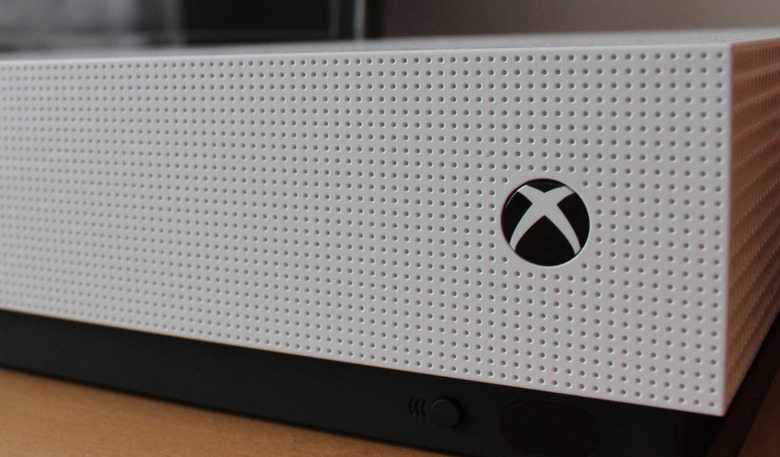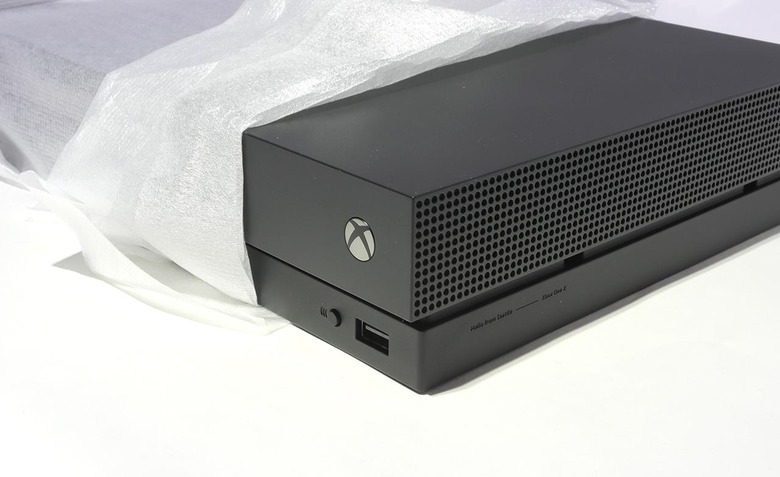Don't Buy Into PS5 And Project Scarlett Hype Yet
It's a pretty exciting time for fans of video games. We're coming off an E3 that was pretty successful despite the fact that a couple of major players – namely Sony – didn't host press conferences this year. On top of that, we now know that the next generation of game consoles is nearly upon us, with both Sony and Microsoft sharing the first details about their next gaming machines.
Even though we have hard confirmation that these consoles are coming – and in the case of Microsoft's Project Scarlett, we have a rough idea of when it's coming – we're still very early on. While it's exciting to think that the next generation is right around the corner, it's probably not the best idea to get too hyped before we have all the details.
What we know about PlayStation 5
So far, the bulk of our information on the PlayStation 5 comes from an interview Sony's Mark Cerny did with Wired back in April. In that interview, Cerny was surprisingly specific about some things and almost frustratingly vague about others.
He explained that the PS5 will use an eight-core AMD CPU based on the third-generation Ryzen and built using the company's 7nm Zen 2 microarchitecture. He also said that the custom AMD Navi GPU will support ray tracing, which is a pretty big deal for a console. He talked up the console's audio capabilities too, noting that the PS5's CPU will support 3D audio that leverages virtual surround sound without the need of additional hardware.

A lot of Cerny's attention, however, was on the console's storage, as odd as that may seem at first blush. Instead of describing the SSD inside the PS5, he made his point by showing Wired a demo in which he fast travels from one part of Manhattan to another in Insomniac's Spider-Man. On a PS4 Pro, that fast travel sequence took 15 seconds, but on the PS5 dev kit Cerny had on hand, it only took 0.8 seconds.
That, obviously, has some exciting implications for next-generation console gaming, with Cerny going so far as to claim that the PS5 SSD's raw bandwidth is higher than any PC SSD that's currently available. Cerny also confirmed some more miscellaneous details about the PS5 during that interview, revealing that the console will indeed have a disc drive and offer some level of backward compatibility. It'll also output in 8K resolution, assuming you've got the display to support it (which, at this point in time, you probably don't).
Sony has dropped a few more morsels of information here and there, but most of what we know comes from Mark Cerny's interview with Wired. While Cerny didn't specifically talk about release timing, Sony said at the end of April that the PlayStation 5 won't be launching within the next 12 months, meaning it'll be here next summer at the earliest, but more likely is a fall or holiday 2020 release for the console.
What we know about Xbox Project Scarlett
The situation is more or less the same for Project Scarlett. Microsoft officially announced the console at E3 2019, primarily in a sizzle video that has a number of Xbox engineers talking about its strengths.
That sizzle video is embedded below, but in case you can't or don't want to watch it, here's a quick rundown of some of the specifications those engineers discuss: Like the PS5, the custom CPU at the center of Project Scarlett will be AMD-made and based on the company's Zen 2 and Navi architecture. Microsoft says the CPU will be four times more powerful than the one in the Xbox One X.
Those engineers then say that Project Scarlett will use "high-bandwidth GDDR6" RAM before firing off some pretty impressive claims about the console's capabilities. We hear that Project Scarlett will support 8K resolution, achieve framerates as high as 120 frames per second, use a variable refresh rates, and support hardware-accelerated ray tracing.
And, like Cerny did in his interview, Microsoft also talked up the SSD in Project Scarlett, boasting that it can be used as virtual RAM and that it represents a 40-fold increase in performance over the current generation. "The combination of the SoC and the solid state drive are really what gives you a totally new experience," one engineer says, while another claims that Project Scarlett will be "the most immersive console experience ever."
Microsoft also confirmed that Project Scarlett will be backward compatible with games from all previous Xbox generations. Xbox chief Phil Spencer also separately confirmed that it will play physical media and that Project Scarlett is only comprised of one console for the time being, though we can certainly see that changing a couple of years after launch.
How much will PS5 and Project Scarlett cost?
All of that is really exciting, isn't it? Here at the start, when a lot of these ideas are still aren't fully formed (for us at least), Microsoft and Sony probably have the temptation to promise the world. The impending release of new consoles should be exciting, but before you get too hyped, it's probably better to take a deep breath and consider everything we don't know.
For starters, the biggest question of them all – the one of pricing – hasn't been answered yet and probably won't be for a while. Still, it certainly seems like we can safely assume that consoles which are capable of 8K output, hardware-accelerated ray tracing, and loading times that pass by in the blink of an eye are going to be pretty expensive to build.

To put this into perspective a little bit, NVIDIA's cheapest RTX card that's capable of ray tracing – the RTX 2060 – runs around $350. Even though that's on the low end of the RTX line, that's still a decent chunk of change for anyone looking to build a PC. On the high end of the line we've got the RTX 2080 Ti, which comes in at more than $1000.
It's true that NVIDIA recently made some GeForce GTX cards compatible with ray tracing, but the frame rates that NVIDIA reported with ray tracing turned on suggest that this was more to give people a taste for the tech and prompt them to upgrade to newer RTX cards.
Obviously, using the cost of PC hardware to try to determine how much an upcoming console might cost isn't a perfect method by any stretch – Microsoft and Sony definitely aren't going to paying consumer prices when they drop massive bulk orders for the CPUs and GPUs that will sit at the core of their consoles. It's still worth mentioning though, if only because it drives home the notion that hardware that can support these features isn't going to be cheap, regardless of the kind of discounts Microsoft and Sony will be getting.

So, where does that leave us? The Xbox One X costs $500, and that really feels like the upper limit of what the market will bear when it comes to console pricing. Remember when Kaz Hirai got up on stage at E3 all those years ago and announced that the 60GB PlayStation 3 was going to cost "five hundred and ninety-nine US dollars"? Of course you do, because his announcement turned into a meme that still persists to this day.
There's a good reason for that too, because consoles are supposed to be a cheaper, more accessible alternative to gaming PCs. I don't know exactly where it is, but it seems like there would be a certain price point where a good number of consumers would simply decide to build a gaming PC instead of buying a console.
Either these 8K, 120fps, ray tracing, SSD-as-virtual-RAM consoles are going to cost a significant amount more than the $300 consoles we've got now, or Sony and Microsoft are going to take hefty losses on each console sold. That second scenario actually isn't out of the question – consoles are normally sold at a loss (unless you're Nintendo) with software sales being what actually brings in the cash.
With both Microsoft and Sony poised to dive into game streaming in a big way in the next generation, it's quite possible that both companies are willing to take a larger-than-normal loss on each console sold because they assume they'll have more ways to get back in the black. If Microsoft and Sony want to see widespread early adoption, I'd say that a $400 price point would be the one to meet, but speculation on price is currently all over the place and the specifications that have been shared suggest a price point that could be higher.
Sony's official video comparing performance of PS4 Pro vs next-gen PlayStation pic.twitter.com/2eUROxKFLq
— Takashi Mochizuki (@6d6f636869) May 21, 2019
Beyond the issue of pricing, there's also the simple fact that we haven't seen these consoles in action yet. The tweet embedded above shows a PS4 Pro vs PlayStation 5 comparison similar to the one Mark Cerny demoed for Wired, but aside from that, we have yet to see any games running on these consoles. It's easy to talk about what your new console will be capable of, but it's another thing entirely to actually show that capability to consumers.
Am I saying that Microsoft and Sony are lying about the capabilities of the PS5 and Project Scarlett? No. What I am saying is that maybe 120fps framerates won't be the standard experience across all games. Maybe ray tracing will be widely available in Project Scarlett and PS5 titles, but maybe it'll drop framerates to a level that most people don't want to play games at. There are a lot of potential variables that haven't been covered yet, and as a result, we don't really have a clear picture of what the typical user experience will be for these consoles.
Wrap Up
Of course, I'm not arguing that you shouldn't look forward to the next generation; I certainly am, despite the fact that PC is my primary platform. It's just that at this early stage, when Microsoft and Sony are mostly concerned with building that excitement, it's easy to get caught up in all the hype – and that can lead to disappointment when that hype is based on an incomplete understanding of just what these consoles can and can't do.
For now, it's probably best to just sit back and look forward to what the next generation may bring without being swept away by thoughts of face-melting consoles that can go toe-to-toe with enthusiast-level gaming PCs. I could always be proven wrong, but anticipating that seems like a surefire way to be let down in the end.
